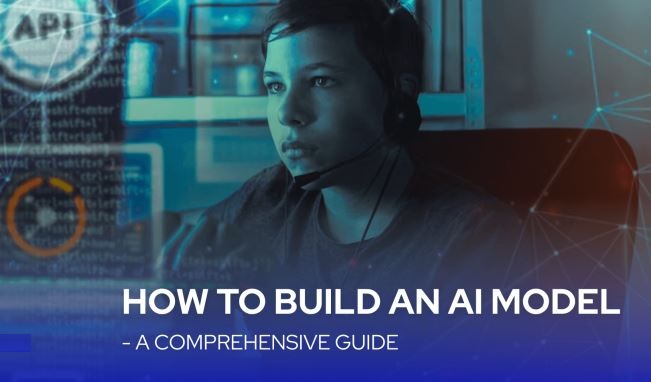Stories you may like
How to Build an AI Model – A Comprehensive Guide
What is An AI Model?
An AI model is a sophisticated computational system designed to simulate human intelligence through advanced algorithms and learning mechanisms. These models act as the foundation of artificial intelligence applications, allowing machines to process vast datasets, recognize patterns, and make informed decisions. Built using techniques like machine learning, deep learning, and neural networks, AI models analyze data, identify correlations, and predict outcomes with remarkable accuracy.
Unlike traditional software, AI models continually learn and adapt, improving their performance as they process new information. This ability to evolve over time is what sets AI apart from conventional systems. A key feature of AI models is their cognitive capabilities, such as reasoning, problem-solving, and understanding. For instance, generative language models like ChatGPT can create human-like text based on prompts, while image recognition models can accurately identify objects and scenarios from visual inputs.
These capabilities are transforming industries across the board. According to a report by PwC, AI could add up to $15.7 trillion to the global economy by 2030, underscoring the increasing value and impact AI models have on businesses and economies worldwide.
How to Build an AI Model?
Step by Step Approach:
The process of building an AI model involves systematic steps. While the specific details may vary depending on the application and technology used, the following guide provides a comprehensive framework:
Step 1: Define the Problem
The first and most crucial step in building an AI model is understanding the problem you’re trying to solve. Defining the problem with clarity ensures that the AI model is built to meet specific needs. To get started, answer the following questions:
- What outcomes do you expect from the AI model?
- What critical aspects of the problem need attention?
This step involves gathering insights from stakeholders to understand their expectations and the challenges they face. Collaborate with domain experts to gain a deep understanding of the context. Research existing solutions to identify gaps or pain points. By analyzing the problem in detail, you can define measurable success criteria, such as Key Performance Indicators (KPIs).
For example, if you are building an AI model for an e-commerce platform, your KPIs might include improving product recommendation accuracy or boosting conversion rates.
Once the problem is clearly defined, write a comprehensive problem statement that includes:
- Symptoms of the problem.
- Impact on end users or business performance.
- Any constraints or limitations to be aware of during development.
A McKinsey report found that AI adoption can increase business productivity by up to 40%. Thus, defining the right problem ensures that your AI project delivers tangible value.
Step 2: Gather Data
Data is the lifeblood of AI, and the success of your AI model hinges on the quality and relevance of the data you gather. The more representative and clean your data is, the better your model will perform.
Types of Data to Consider:
- Structured data: Data that is highly organized, such as databases or spreadsheets.
- Unstructured data: Data that doesn’t follow a fixed structure, such as text, images, or videos.
- Semi-structured data: Data that combines elements of both, such as JSON or XML files.
There are several ways to gather data for your AI model:
- Public datasets: Use existing datasets from platforms like Kaggle, UCI, or government repositories.
- Web scraping: Collect data from websites, social media, or online platforms.
- Surveys and interviews: Conduct qualitative and quantitative research through surveys or interviews with stakeholders, customers, or domain experts.
- Collaborations: Partner with organizations to access proprietary data.
Ensure that the data you collect is relevant, sufficient, and of high quality. If existing data sources are insufficient, consider augmenting them by gathering more data through surveys, customer feedback, or third-party datasets.
Ethical Considerations: Be mindful of ethical issues such as privacy, consent, and data protection. Ensure compliance with regulations like GDPR when gathering and using data.
According to the International Data Corporation (IDC), 90% of the world’s data has been generated in the last two years, illustrating the massive growth in available data and the importance of utilizing it effectively.
Step 3: Preprocess Data
Raw data is often noisy, incomplete, and unstructured. Preprocessing data is a crucial step to prepare it for analysis and model training. This phase ensures that the data is in the right format and quality for the AI model to learn from it.
Common Data Preprocessing Steps:
- Validation and cleaning: Remove inaccuracies, handle missing values, and eliminate duplicate or irrelevant records. You can use methods like mean imputation, median imputation, or interpolation to deal with missing data.
- Formatting: Normalize or standardize numerical features to ensure they are on a comparable scale. For example, features such as age and income may need to be scaled between 0 and 1. Categorical variables should be encoded, using methods such as one-hot encoding or label encoding.
- Text processing (for NLP models): Tokenize text data, remove stop words (common words that don’t contribute meaning), and apply stemming or lemmatization (reducing words to their base forms).
- Class balancing (for imbalanced datasets): If the dataset is skewed (e.g., more instances of one class than another), apply techniques like oversampling, undersampling, or the Synthetic Minority Over-sampling Technique (SMOTE) to ensure the model is trained fairly.
Preprocessing is a time-consuming but critical step, as it ensures that the AI model has high-quality input data. According to a study by Kaggle, data cleaning and preprocessing account for 80% of the time spent on data science projects.
Step 4: Choose the Right Tools
Selecting the right programming languages and frameworks is crucial for efficiently developing an AI model. The tools you choose should align with the type of problem you’re solving, the complexity of the model, and the infrastructure you have in place.
Popular Programming Languages:
- Python: The most widely used language for AI and machine learning, thanks to its extensive libraries like TensorFlow, Keras, NumPy, Pandas, and Scikit-learn.
- R: Ideal for statistical analysis, data visualization, and simpler machine learning models.
- Java: Often used in enterprise applications, especially where scalability and security are critical.
Common Frameworks:
- TensorFlow: An open-source framework developed by Google for deep learning applications.
- PyTorch: A flexible, open-source machine learning framework that offers dynamic computation graphs, ideal for research and development.
- Keras: A high-level API built on top of TensorFlow, designed to make building deep learning models user-friendly.
Choosing the right tools depends on the problem you’re solving. For instance, if you are working on a deep learning project, TensorFlow or PyTorch would be appropriate, while R is ideal for statistical modeling.
Step 5: Split Data
Dividing your dataset into different subsets is essential to ensure that your model learns from one portion of the data while testing its performance on unseen data. This prevents overfitting, where the model memorizes the training data instead of generalizing.
Typical Data Split:
- Training set (70%): Used to train the model and adjust its parameters.
- Validation set (15%): Used to fine-tune hyperparameters, preventing overfitting and optimizing the model.
- Testing set (15%): Used to evaluate the model’s final performance and generalization ability.
This division ensures that the model has the opportunity to learn from data while being evaluated on new, unseen data.
Step 6: Train the Model
Training the AI model involves feeding it data and allowing it to adjust its internal parameters to reduce the prediction error. The model learns by repeatedly processing the training data, making predictions, and adjusting weights based on the errors.
Training Steps:
- Forward pass: The model takes input data, processes it through its architecture, and generates predictions.
- Loss calculation: The predicted outputs are compared with the actual outcomes, and the error is calculated using a loss function (e.g., Mean Squared Error for regression or Cross-Entropy Loss for classification).
- Backpropagation: The error is fed back into the model to adjust weights and minimize the loss. This process is repeated over several iterations or epochs.
The model’s performance improves with each epoch as it learns from its mistakes.
According to Stanford University, training deep learning models often requires vast computational resources, and many organizations are turning to cloud platforms like AWS and Google Cloud to run these models efficiently.
Step 7: Validate the Model
Once the model is trained, use the validation set to check its performance. This is where hyperparameters like learning rate, batch size, and the number of layers are adjusted to achieve optimal accuracy. Validation helps ensure the model does not overfit to the training data.
Techniques for Hyperparameter Tuning:
- Grid search: Tries all possible combinations of hyperparameters to find the best configuration.
- Random search: Randomly selects hyperparameters to find an optimal combination faster.
Research by Google AI indicates that hyperparameter tuning can boost model performance by up to 5%, emphasizing the importance of this step in improving accuracy.
Step 8: Test the Model
After the model is trained and validated, use the test set to evaluate its overall performance. The test set helps you gauge how well the model will perform when deployed in the real world.
Key Metrics to Assess:
- Accuracy: The percentage of correct predictions.
- Precision: The proportion of true positive predictions out of all positive predictions.
- Recall: The proportion of true positives out of all actual positive instances in the data.
- F1-score: The harmonic mean of precision and recall, useful for imbalanced datasets.
Additionally, consider using k-fold cross-validation, which splits the data into k subsets and trains the model k times, each time with a different subset used for validation. This method improves the robustness of the evaluation.
Step 9: Deploy the Model
Deployment involves taking the trained AI model and integrating it into a production environment where it can provide value. This step includes setting up APIs, web apps, or embedding the model into existing systems.
Deployment Considerations:
- API integration: Expose the model via an API, allowing other applications to make predictions.
- Data security: Ensure the model is deployed with appropriate authentication, encryption, and data protection measures.
- Performance testing: Conduct load and stress testing to ensure the model can handle real-world traffic and high usage volumes.
According to a PwC report, 68% of businesses have yet to scale their AI models, largely due to challenges related to model deployment and maintenance.
Step 10: Monitor and Maintain the Model
AI models require ongoing monitoring and maintenance to ensure they remain accurate and effective over time. As data patterns evolve and new information becomes available, the model may need to be retrained or updated.
Monitoring Activities:
- Performance tracking: Monitor key metrics such as accuracy, response time, and system load.
- Retraining: Periodically retrain the model with new data to maintain relevance and prevent model drift.
- Version control: Use version control to manage updates and ensure backward compatibility when changes are made.
A report by PwC reveals that 52% of organizations struggle with maintaining their AI systems, highlighting the importance of continuous monitoring.
How Much Does It Cost to Build an AI Model?
The cost of building an AI model can vary greatly depending on several factors, including data acquisition, infrastructure, and development time.
1. Data Acquisition: High-quality data is essential for training AI models, and acquiring it can be costly. While public datasets are often free, domain-specific or proprietary data may require significant investment, sometimes amounting to thousands of dollars. Additionally, data preprocessing tasks like cleaning and labeling further add to the cost.
2. Infrastructure Costs: AI models, particularly those involving deep learning, require powerful computing resources. Cloud services like AWS, Google Cloud, and Microsoft Azure provide scalable solutions, but their usage comes with significant costs, as they charge based on computational power, storage, and bandwidth. Using GPUs or TPUs for intensive training can lead to considerable expenses, especially for long-duration projects.
3. Development Time and Expertise: Skilled AI engineers are essential for building effective models, with an average annual salary of around $155,000, according to ZipRecruiter. Smaller AI projects typically cost between $10,000 and $50,000, while larger, enterprise-scale solutions can surpass $500,000, depending on the complexity and duration of the development process.
Challenges and Solutions in AI Model Development
Data Scarcity
Data scarcity is a prevalent challenge in AI model development. According to a report by McKinsey, data availability remains one of the most significant obstacles to scaling AI, with 80% of organizations struggling to access sufficient and high-quality data for training. To overcome data scarcity, techniques like data augmentation can be used, where existing data is modified slightly (e.g., rotating or flipping images) to create more training examples. Synthetic data generation using Generative Adversarial Networks (GANs) can also help simulate realistic datasets, filling gaps when real data is limited. In fact, synthetic data can increase the diversity and volume of training data by up to 30%, making it an effective tool for addressing data scarcity.
Model Complexity
AI models, particularly deep learning models, can become highly complex, making them difficult to interpret and deploy. According to the 2024 AI Index Report, model interpretability remains a critical concern, with over 60% of AI professionals citing it as a barrier to widespread adoption. Simplifying model architectures is key, focusing on essential features and reducing the number of parameters. Techniques like model pruning and knowledge distillation can simplify large models while maintaining performance, making them more interpretable and easier to deploy in production environments.
Bias in Data
AI models are often prone to bias, especially when trained on unbalanced or non-representative datasets. A 2023 study by MIT found that bias in AI algorithms disproportionately affects minority groups, with facial recognition algorithms being up to 34% more likely to misidentify Black individuals compared to white individuals. To mitigate bias, methods like re-sampling or re-weighting the dataset can ensure more equitable representation. Additionally, regular audits and introducing fairness constraints during training help reduce bias and improve model fairness.
Scalability
As AI systems scale, the demand for computational resources grows. Cloud computing services like AWS, Google Cloud, and Microsoft Azure provide elastic scalability, which is essential for managing the increasing volume of data and user interactions. In 2023, the cloud AI market was valued at $16.87 billion and is projected to grow at a compound annual growth rate (CAGR) of 39.8% by 2030, indicating the critical role of cloud services in scaling AI solutions.
Ethical Concerns
AI ethics remains a central issue, particularly in areas involving privacy, security, and fairness. According to a 2023 Gartner report, AI governance and ethical concerns will be a major focus for organizations in the coming years, with 90% of AI projects facing scrutiny over ethical practices by 2025. Developers must adhere to ethical guidelines, ensuring transparency, accountability, and fairness. This includes implementing systems that are explainable, protecting user privacy, and promoting non-discriminatory decision-making.
Performance Monitoring
Once deployed, AI models require continuous monitoring to ensure they perform accurately. According to the AI Index, 47% of companies that have deployed AI models face challenges in performance tracking. Automated monitoring systems that track real-time metrics and flag performance issues are essential for ensuring models remain accurate and efficient. These systems help catch problems like data drift and model degradation, allowing for timely interventions and updates.
Types of AI Models
Supervised Learning
Supervised learning involves training a model on labeled data, with a clear input-output relationship. Examples of supervised learning models include linear regression for predicting continuous outcomes and neural networks for more complex tasks. According to the AI Index, supervised learning accounts for 75% of machine learning models deployed in industry today, making it one of the most common AI approaches.
Unsupervised Learning:
In unsupervised learning, the model identifies patterns from unlabeled data. Techniques like clustering (e.g., k-means clustering) and Principal Component Analysis (PCA) are commonly used. The global market for unsupervised learning applications is expected to grow at a CAGR of 27.5% from 2023 to 2030, as businesses increasingly use it for customer segmentation, anomaly detection, and exploratory data analysis.
Reinforcement Learning:
Reinforcement learning (RL) is used in environments where agents learn by interacting with the environment to achieve a goal. In 2024, Reinforcement Learning-based solutions are expected to drive significant growth in robotics, with the global RL market estimated to reach $26.64 billion by 2027. RL is especially prominent in robotics and gaming, where agents receive rewards based on their actions, making it ideal for optimizing tasks over time.
Deep Learning:
Deep learning, a subset of machine learning, uses neural networks with multiple layers to model complex patterns. For example, Convolutional Neural Networks (CNNs) are widely used for image recognition, and Recurrent Neural Networks (RNNs) excel at sequential data, like time-series analysis. As of 2023, deep learning models account for 25% of all AI models and continue to be pivotal in fields such as natural language processing (NLP) and autonomous vehicles.
Generative Models:
Generative models aim to create new data similar to the input data. Generative Adversarial Networks (GANs) are commonly used to generate realistic images, videos, and even text. The generative AI market is expected to grow at a CAGR of 42% from 2023 to 2030, driven by the increasing demand for synthetic data creation, content generation, and virtual reality applications. GANs, for instance, can generate realistic human faces and are widely used in entertainment and simulation industries.
Build AI Model Development Solutions With Oyelabs
Oyelabs excels in developing cutting-edge AI models specifically designed to meet your business goals. From defining the problem to deploying the final solution, we offer complete, end-to-end services that foster innovation and drive operational efficiency. Our team leverages advanced machine learning, deep learning, and neural networks to create intelligent systems that provide valuable insights, streamline processes, and automate tasks.
Whether you need predictive analytics, personalized recommendations, or AI-driven automation, we tailor solutions that fit seamlessly into your business environment. By partnering with us, you gain access to state-of-the-art AI technology that not only solves challenges but also drives growth and competitive advantage in today’s data-driven world.
Conclusion
Building an AI model requires a systematic and strategic approach, blending technical know-how with ongoing optimization. Following the outlined steps—from problem definition to deployment—ensures you create effective AI models that address real-world challenges, improve efficiency, and enhance decision-making. As AI continues to evolve and shape industries, adopting intelligent solutions becomes essential for staying ahead of the competition. With AI, businesses can unlock new opportunities and maintain agility in a fast-changing digital landscape. Let Oyelabs guide you through this transformative journey with our expertise, helping you develop AI solutions that drive innovation, efficiency, and growth for your business





User's Comments
No comments there.